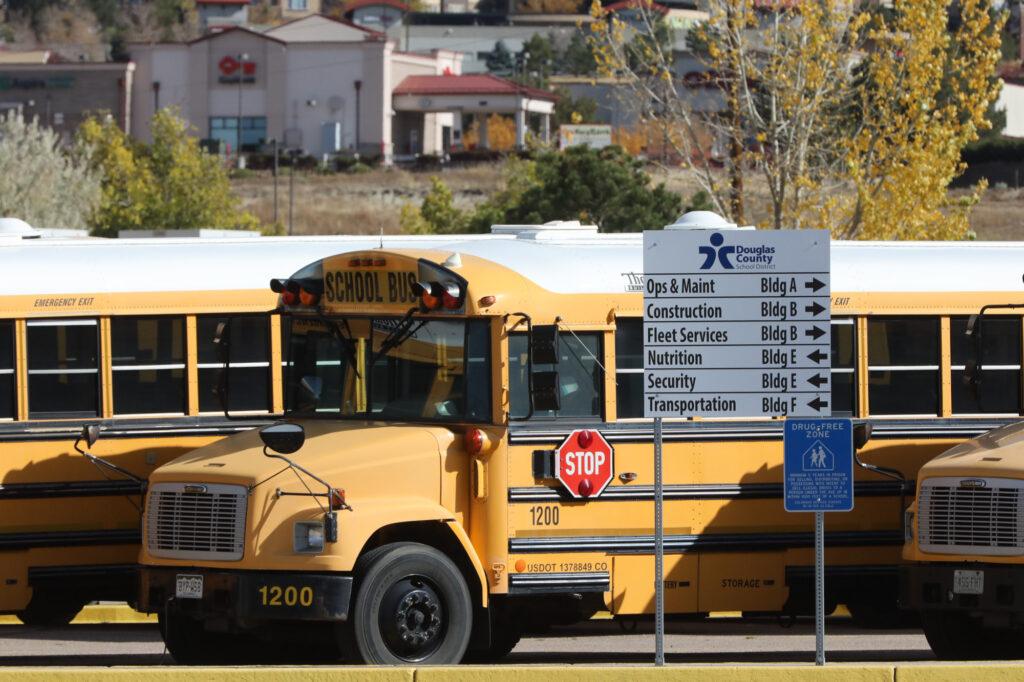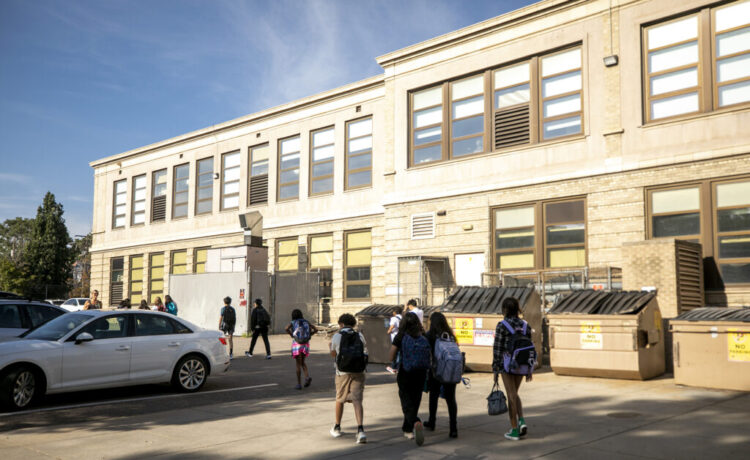Diego is a high school student in Lafayette. Despite his brilliance and creativity, he may not graduate.
His challenges are many: unstable housing (he lives with his aunt), learning English, and mental health issues.
“Last year he was often absent or visibly overwhelmed with anxiety and depression,” his English teacher Karen Amadon told a committee of lawmakers on April 18, 2024.
When Diego’s school cobbled together targeted language instruction, one-on-one tutoring, mental health support, and a school-based family liaison last fall, he began flourishing. But when the temporary support fell away, Diego’s attendance began plummeting.
“His story is a stark reminder of the impact our educational investments have on individual lives,” she told lawmakers on the House Education Committee.
Amadon was one of several teachers who testified in support of House Bill 1448, one of the most significant pieces of legislation under consideration this session because it would overhaul Colorado’s three-decades-old school funding formula by sending more resources to students like Diego. State legislators, superintendents, and others have tried to update the formula multiple times. Whether at the ballot box or the state Capitol, each attempt failed.
The latest attempt is spearheaded by House Speaker Julie McCluskie. Its first hearing elicited enthusiastic support but also worry and uncertainty.
“I know this is a difficult conversation,” said co-sponsor Rep. Jennifer Bacon. “I don’t know if we will ever, ever, ever get to a hundred percent consensus, but that is not a reason to not move forward.”

Jenny Brundin/CPR News
What would the new formula do?
The new formula draws upon some of the recommendations of a special bipartisan school finance task force. The formula’s weights for students living in poverty and students learning English would be increased and for the first time would put a weight on special education students. (A separate pot of money for special education students will also increase.)
That’s a change from the current formula, where up to $1.3 billion of education money is driven to districts with high costs of living instead of the characteristics of students.
“It is about increasing funding for students most in need,” said McCluskie.

Hart Van Denburg/CPR News
With a six-year phase-in, the bill would plow $500 million more into K-12 schools. The bill proposes taking $84 million a year cumulatively from either the state’s general fund or the $1.5 billion education fund.
Even though 97 percent of districts would get more money, the difference in how much school districts would get is significant.
Districts with high numbers of students living in poverty would draw more dollars
Districts like Mapleton, where 40 percent of students are chronically absent, Center Consolidated, where 90 percent of students live in poverty, and Greeley Evans 6, where students depend on schools for mental health services, laundry, and shower facilities lined up in support of the bill.
“These are the types of needs that have not been recognized by the current funding formula for over 20 years,” said Michael Mathews, president of the Greeley Evans 6 school board. “Our most vulnerable students in Colorado have not had the resources that are absolutely necessary for them to succeed in school. For over 20 years, these students have been the losers.”
Sarah Peterson, an assistant principal at Denver’s Bruce Randolph High School said especially with the new arrivals from Central and South America, her English language learner classes have 35 students when they should enroll 15.
“We are maxed out. We actually had to stop taking new students because our classes are full,” she told the committee. “That is not serving our English language learners.”
Peterson, who testified for the bill, said a bump in funding would allow more staff. She said her school’s ratio of school psychologists and social workers to students is 250 to 1.
Teachers who testified said it is possible to improve outcomes with more funding targeted to high-needs students.
Laura Haller, a Denver Public Schools special educator, recounted a time when her school had money for a fourth special educator so group sizes could be reduced. Students, many of whom were English language learners, grew academically in literacy and math over a year. Then they lost the fourth person.
“They absolutely can perform like their typical peers. And our educational system hasn’t delivered the results students need due to a lack of funding, but they can do it, and we need your help to get them there,” Haller said.

Chris Neal/Shooter Imaging
The bill also directs more remote rural districts. Karen Cheser, the superintendent of the Durango School District, also testified for the bill. She said building, food, and insurance costs are higher there.
“We’re paying $25,000 a week, yes, a week, for charter buses to transport our athletic and academic teams to competition since we have to travel so far and we have a lack of bus driver supply, especially willing to drive over mountain passes.”
Other districts are concerned about shuffling money from one place to another
Districts like Adams 12 Five Star, Littleton, Boulder Valley, Cherry Creek, and Douglas County have lined up to oppose the bill.
Because Colorado funds its schools significantly below the national average and only just ended a practice that has withheld $10 billion from school coffers, some of the state’s 178 school districts are nervous about any changes that would take money from one school district and send it to another. Districts never recovered from the deep cuts they made in programming and staff during those years.
“We’ve starved them for 14 years,” said Rep. Tammy Story, who voted against the bill.
Some worry that until schools are funded adequately, it doesn’t make sense to shuffle money from one place to another. Jonathan Levesque, the chief financial officer of Littleton Public Schools, said they are worried that the bill “pushes school districts off of a fiscal cliff in just a few years without a clear source of identified revenue.”
Some want the overhaul to wait until January 2025 when a $3 million adequacy study will be released that is the first attempt to calculate precisely what supports and how much it actually costs to educate a child to standards.

Hart Van Denburg/CPR News
Douglas County has fewer students in poverty and also receives among the lowest amount of funding in the state. It would barely see more money under the new formula.
“This would only make those disparities significantly worse,” testified Douglas County School District Superintendent Erin Kane.
Kane said in order to direct more money, “which is the really good intention of the bill,” to the district’s 10,000 students who live in poverty, she would need to make more than $30 million in cuts across the school district.
“These students (in poverty) deserve your support as much as students in other parts of the state do,” she said. “I urge you to hold off on implementing changes until it can be done with all of the students who are in these subgroups in mind regardless of where they happen to live.”
Douglas County is already laboring to retain educators who are paid up to $20,000 less than teachers in neighboring districts. Some districts want the base funding for all students to be lifted first by identifying a new funding source.
Adams 12 Five Star Superintendent Chris Gdowski told the committee the bill misses the real issue that some districts can raise far more from their local taxpayers than others.
“The differences in override revenues between districts in the metro are stunning,” he said.
For example, Adams 14 receives $900 more per student from its local taxpayers while Englewood receives $4,500 more. Gdowski said his district has more than 50 vacancies for special education teachers because they can’t equal the salaries of surrounding districts.
“So, if we don’t solve for this (mill) levy override issue … you’re going to continue to have vacancies that are going to put us short of serving the very kids that the bill purports to want to serve.”
Other uncertainties; possible property tax changes ahead could dramatically change revenue for schools
Great Education Colorado’s Lisa Weil said the bill is a huge step forward for equity but she is worried about its long-term sustainability.
“There is a ticking time bomb waiting to go onto the ballot, Initiative 50, that would decimate property tax revenues in this state,” said Weil.
McCluskie said there is a safety clause that if there is another pandemic or recession, the legislature can pause the implementation of the formula.
There is something else causing heartburn for some education groups, even supporters of the bill. It calls for two studies at a cost of about $2 million, which critics say makes the bill unpredictable.
One would focus on counting students over multiple days over a period of time, rather than a single count day that Colorado has now. Some districts worry that this could significantly change the funds they get. The other study is more controversial, it’s a weighted student funding or so-called “backpack” funding that follows a child to their school. Critics worry the concept mirrors model legislation from the American Legislative Exchange Council, a nonprofit organization of conservative state legislators and others dedicated to the principles of limited government and free markets.
“This model legislation explicitly names backpack funding as a means to privatize the public school system,” said Amie Baca-Oehlert, president of the Colorado Education Association.
McCluskie said that is not what the study is about.
“We want to make sure that the schools, the classrooms that have students with greater needs are getting more resources,” she said.
Bill sponsors say equity can’t wait.
“We are a quarter into the 21st century and we have not made 21st-century adjustments,” said Rep. Bacon. “We cannot any longer protect what has become the status quo.”
After four and a half hours of debate, the bill passed its first legislative test – the House Education Committee — on an 8 to 3 vote. It is now in the House Appropriations Committee.















